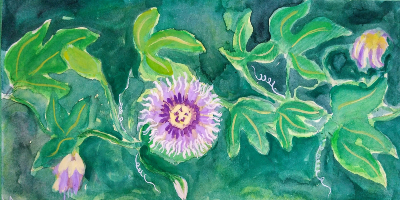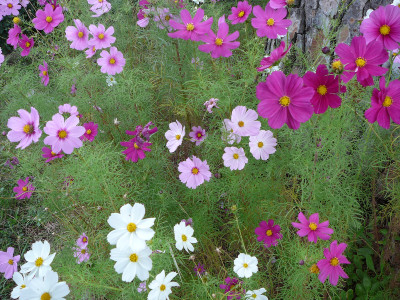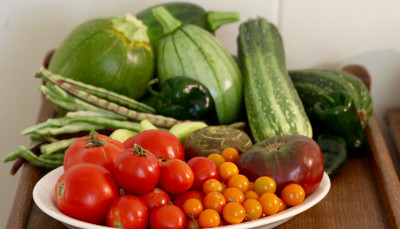
bringing nature, nurseries and gardeners together July 24, 2020
|
|
Barton Springs Nursery: plentiful amounts of citrus in stock: pixie mandarin, Owari satsuma, Meyer lemon and thornless Mexican lime). Barton Springs Nursery
Far South Nursery: Happy 20th anniversary. Congratu-lations to Henry, Heather, Crystal, Jerry and all the crew down there. They have a fine selection of plants that "aren't afraid of the Texas summers." Nolina, sotol, agave and a variety of cacti. Far South
Natural Gardener: 20% off all perennials & wind chimes: today - Aug.1 New shipment of citrus trees just in . TNG
Sledd Nursery: 20% sale on caladiums. 1211 W. Lynn Street, 78703 Sledd
Wildflower Center: open, but reserve a spot ahead of time: Admissions

Color theory in the garden: "Color is one of the most visible ways of expressing your personality in the garden. A color palette can be bold and playful or restrained and demure. It can excite or calm. Color allows us to paint our personalities in the garden." New York Botanical Gardens ❦

Rage gardening: as racial tensions erupted last month, writer Shanna B. Tiayon adapted the idea of 'rage baking' into something for her garden. "Instead of exorcising your rage into flour, butter and sugar, rage planting is pouring that same rage into the soil to nurture a plant life into the world that can nourish your body and the body of others." Food & Wine ❦

Passion vine: this other-worldly, deciduous vine is a host for gulf fritillary and zebra longwing butterflies. Herbalists prescribe it for insomnia, anxiety and ADHD. Passiflora incarnata is also fairly rambunctious, and will happily spread across your garden and up your trees ; - ) Painting for the Austin Garden by Linda Anderson. ❦
CTG Zoom Special: Fireflies Naturalist Ben Pfeiffer (Firefly Conservation & Research) shares info on how to recognize these beetles in all life cycles, how larvae control snails and slugs, and easy ways to make your garden firefly-friendly for nature's fireworks. YouTube ❦
 Practices Tried and True
by Renee Studebaker
While some folks may be wondering if the current spikes in Covid-19 infections will lead to another toilet paper shortage in the fall, gardeners I know are wondering about possible seed shortages — and record-breaking heat waves.
Although I can’t do a thing about toilet paper, I can offer a bit of good news regarding seeds. It’s true that some nurseries and online seed companies have experienced shortages because of higher demand during the pandemic, but everyone I talked to recently said they expect to be fully restocked by early August.
As for the heat, well, all I have to say is Hurry Up October. Meanwhile, here are some tried and true practices that might be helpful as you transition into the fall gardening season:
1. They go by a lot of names — black-eyed peas, field peas, cowpeas, and Southern peas — but whatever you call them, they’re all prolific, drought tolerant, high protein, tasty, and easy to grow through the heat of a Texas summer. I grew up eating and loving purple hull peas, so that’s what I mostly grow, but I also love Old Settler peas, Texas cream peas, and Whippoorwill peas. They’re actually beans, not peas, but’s that’s a story for another day. Now is a good time to plant.
 Bountiful harvest from Reneee's garden: tomatoes: Cherokee purple, sun gold, bella rosa and fourth of July; squash -- tatume and costata romanesco; poblano peppers; and purple hull peas (photo: Renee Studebaker)
2. To get a decent crop of squash, I plant tatume, Waltham butternut, and Costata Romanesco (the heirloom, open-pollinated version). I plant at least two times more then I think I’ll need because a lot of plants won’t survive the inevitable squash vine borer damage. I add plenty of good compost to the soil, and I give the vines room to roam so they can put down new roots and outrun the SVBs.
3. Wood chips. Love them. Not ideal for vegetable beds, but perfect for paths and for mulch around woody perennials and fruit trees. Not the shredded stuff you buy by the bag, but the chunky stuff you can get free from neighborhood tree trimmers, if you can catch them before they take their trimmings to the dump. Lots of good research in the last few years on the almost magical effects wood chips have on soil health.
4. Weed fabric — Don’t. Just don’t. Mow or weed-eat weeds and grass down to ground level and then cover with wood chips instead. Every time I have used weed fabric, I have regretted it. Weeds and Bermuda grass eventually come up through the fabric and then I have a real mess on my hands.
5. It’s not easy to start seeds during the high heat of a Texas summer. Try this: make a furrow, fill it with a thin layer of seed starter mix or finely sifted compost, place seeds in the furrow, and then top the seeds with more mix or compost. Keep the seeded area moist until germination, which may mean watering twice a day.
6. For butterflies, bees, and beautiful blooms from July to December, cosmos is one of my favorites.
Cosmos reseeds freely, which means I get volunteers all over, but that’s OK because I just pull up the ones I don’t want. Cosmos seeds actually sprout faster in hot soils, and the plant grows best in hot, dry summer temperatures. So go ahead and plant seeds now — but water well until they germinate.
7. For longer lasting sweet basil, don’t just trim the tips. Snip four or more inches at a time, and don’t let the plants get stressed from lack of water. With open pollinated Thai basil, I go ahead and let it bloom and throw off seed so I have tender new babies in the fall and the following spring.
8. Tomato transplants can go in now, if you can find them in the nurseries. Or you can air layer your overgrown indeterminate spring plants. Trim away any bug- or blight-damaged stems and leaves. Choose a long stem that has healthy top growth and trim off all its lower leaves. Keeping the stem attached to its mother plant, lay it down on the soil and cover all but about 5 inches of its top growth with soil. Then top the soil on the stem and around the mother plant with compost. Keep the mother plant and its planted stem well watered until the stem produces new roots and starts growing a new plant.
9. Speaking of tomatoes, Sun Gold and Cherokee Purple are on my “always plant” list, but Burpee’s Fourth of July, which I’ve grown from seed for the past two years, is fast becoming a contender. It’s very early (50 days to maturity), full flavored, disease resistant and a heavy producer all the way to frost. My Fourth of July plants have even managed to set new fruit this month.
10. And finally, washing the roots of woody perennials and trees before planting has become a standard best practice, and if you’ve never tried it, it’s easier than it sounds. Take the plant out of the pot and use a hose and your hands to dislodge all of the soil in the root ball. Check the roots and prune any that are crossed or girdled. Use your native soil as back fill. Best done in fall when it’s easier to keep the plant adequately watered while it’s settling into its new home. ❦
Longtime Austin gardener and writer Renee Studebaker is a retired newspaper journalist who now teaches children how to grow and cook vegetables.
|
 It's About Thyme Legacy Publications.
Contact newsletter editor Darrel Mayers with any ideas for articles or interesting links at internationalrain@yahoo.com (hitting 'reply' to this email won't work) |
|
|
